Check answers here:
CCNP ENARSI v8 Final Exam Answers Full
Quiz-summary
0 of 115 questions completed
Questions:
- 1
- 2
- 3
- 4
- 5
- 6
- 7
- 8
- 9
- 10
- 11
- 12
- 13
- 14
- 15
- 16
- 17
- 18
- 19
- 20
- 21
- 22
- 23
- 24
- 25
- 26
- 27
- 28
- 29
- 30
- 31
- 32
- 33
- 34
- 35
- 36
- 37
- 38
- 39
- 40
- 41
- 42
- 43
- 44
- 45
- 46
- 47
- 48
- 49
- 50
- 51
- 52
- 53
- 54
- 55
- 56
- 57
- 58
- 59
- 60
- 61
- 62
- 63
- 64
- 65
- 66
- 67
- 68
- 69
- 70
- 71
- 72
- 73
- 74
- 75
- 76
- 77
- 78
- 79
- 80
- 81
- 82
- 83
- 84
- 85
- 86
- 87
- 88
- 89
- 90
- 91
- 92
- 93
- 94
- 95
- 96
- 97
- 98
- 99
- 100
- 101
- 102
- 103
- 104
- 105
- 106
- 107
- 108
- 109
- 110
- 111
- 112
- 113
- 114
- 115
Information
CCNP ENARSI v8 Final Test Online
You have already completed the quiz before. Hence you can not start it again.
Quiz is loading...
You must sign in or sign up to start the quiz.
You have to finish following quiz, to start this quiz:
Results
0 of 115 questions answered correctly
Your time:
Time has elapsed
You have reached 0 of 0 points, (0)
| Average score |
|
| Your score |
|
Categories
- Not categorized 0%
- 1
- 2
- 3
- 4
- 5
- 6
- 7
- 8
- 9
- 10
- 11
- 12
- 13
- 14
- 15
- 16
- 17
- 18
- 19
- 20
- 21
- 22
- 23
- 24
- 25
- 26
- 27
- 28
- 29
- 30
- 31
- 32
- 33
- 34
- 35
- 36
- 37
- 38
- 39
- 40
- 41
- 42
- 43
- 44
- 45
- 46
- 47
- 48
- 49
- 50
- 51
- 52
- 53
- 54
- 55
- 56
- 57
- 58
- 59
- 60
- 61
- 62
- 63
- 64
- 65
- 66
- 67
- 68
- 69
- 70
- 71
- 72
- 73
- 74
- 75
- 76
- 77
- 78
- 79
- 80
- 81
- 82
- 83
- 84
- 85
- 86
- 87
- 88
- 89
- 90
- 91
- 92
- 93
- 94
- 95
- 96
- 97
- 98
- 99
- 100
- 101
- 102
- 103
- 104
- 105
- 106
- 107
- 108
- 109
- 110
- 111
- 112
- 113
- 114
- 115
- Answered
- Review
-
Question 1 of 115
1. Question
1 pointsRefer to the exhibit. A network engineer has performed a partial configuration to prevent routes from being reinjected. What is the next configuration that should be issued?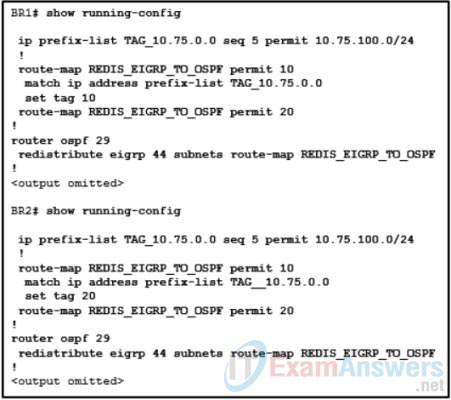 Correct
Correct
Incorrect
-
Question 2 of 115
2. Question
1 pointsIn which two situations is a metric not required for performing redistribution into the EIGRP routing process? (Choose two.)Correct
Incorrect
-
Question 3 of 115
3. Question
1 pointsRefer to the exhibit. A network engineer has issued the commands shown on a boundary router. What are two results of the network engineer issuing this command? (Choose two.) Correct
Correct
Incorrect
Hint
The EIGRP command distance 66 172.16.55.1 0.0.0.0 90 changes the AD to 66 for all EIGRP routes learned from neighbor 172.16.55.1 that match the specific network prefix of ACL 90. -
Question 4 of 115
4. Question
1 pointsWhat type of BGP message precedes the successful formation of a BGP peering session?Correct
Incorrect
Hint
A BGP open message is used to establish a BGP adjacency. Both peer sides negotiate session capabilities before BGP peering is established. -
Question 5 of 115
5. Question
1 pointsRefer to the exhibit. A network administrator is configuring BGP on a router. Which configuration step is needed in order to establish the BGP session with the neighbor router?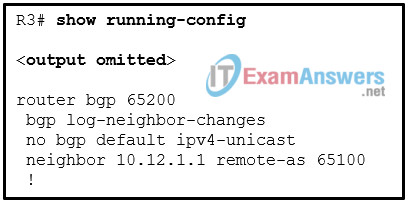 Correct
Correct
Incorrect
Hint
For a BGP session to initiate, one address family for a neighbor must be activated. On Cisco routers the IPv4 address family is activated by default; however, it may cause confusion when working with other address families. The BGP router configuration command no bgp default ip4-unicast disables the automatic activation of the IPv4 AFI. -
Question 6 of 115
6. Question
1 pointsWhich two statements describe the BGP weight attribute? (Choose two.)Correct
Incorrect
Hint
BGP weight is a Cisco-defined attribute and the first step in selecting the BGP best path. Weight is a 16-bit value (0 through 65,535) assigned locally on the router; it is not advertised to other routers -
Question 7 of 115
7. Question
1 pointsMatch the preference, that is used by the BGP origin attribute in best path calculation, to the order.Correct
Incorrect
-
Question 8 of 115
8. Question
1 pointsA network administrator is configuring BGP multipathing for paths learned from iBGP advertisement. What is a condition for additional paths to be considered equal to the best path?Correct
Incorrect
Hint
When you configure BGP multipathing, the additional paths need to match the following best-path BGP path attributes:- Weight
- Local preference
- AS_Path length
- AS_Path content (although confederations can contain a different AS_CONFED_SEQ path)
- Origin
- MED
- Advertisement method (iBGP or eBGP) (If the prefix is learned from an iBGP advertisement, the IGP cost must match for iBGP and eBGP to be considered equal.)
-
Question 9 of 115
9. Question
1 pointsA network administrator is troubleshooting an issue with a DMVPN tunnel. From the output of the show dmvpn command, the administrator notes that the tunnel is in the IPsec state. What problem does this state indicate?Correct
Incorrect
Hint
The command show dmvpn [detail] provides the tunnel interface, tunnel role, tunnel state, and tunnel peers with uptime. When the DMVPN tunnel interfaceis administratively shut down, there are no entries associated to that tunnel interface. The tunnel states are, in order of establishment: – INTF: The line protocol of the DMVPN tunnel is down. – IKE: DMVPN tunnels configured with IPsec have not yet successfully established an Internet key exchange (IKE) session. – IPsec: An IKE session is established but an IPsec security association (SA) has not yet been established. – NHRP: The DMVPN spoke router has not yet successfully registered. – Up: The DMVPN spoke router has registered with the DMVPN hub and received an ACK (positive registration reply) from the hub. -
Question 10 of 115
10. Question
1 pointsRefer to the exhibit. A network administrator is configuring Phase 1 DMVPN. The hub router RH1 and the spoke router RS2 are already configured and the administrator is finalizing configurations on spoke router RS3 by mapping the NHRP and NHS addresses for the DMVPN hub. Which configuration should the administrator use for the ip nhrp map command?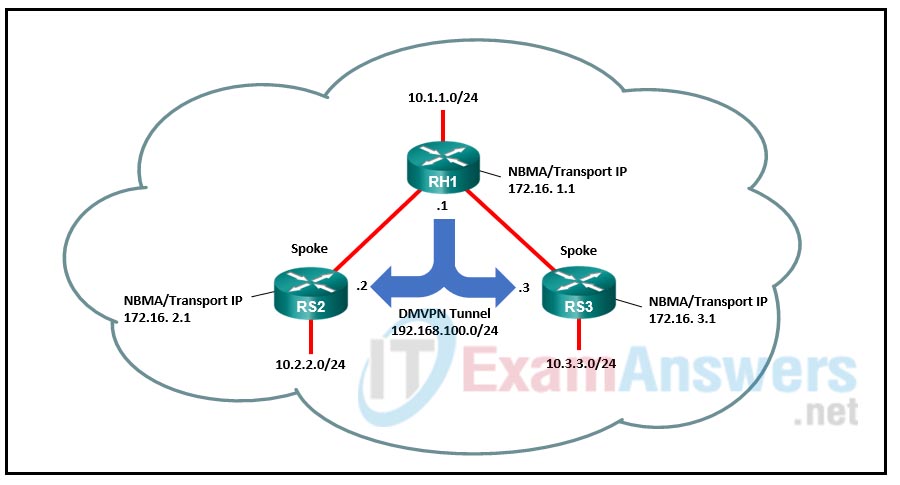 Correct
Correct
Incorrect
-
Question 11 of 115
11. Question
1 pointsWhich NHRP message type notifies routers of routes used by NHRP that are no longer available?Correct
Incorrect
Hint
Purge messages are sent to remove a cached NHRP entry. Purge messages notify routers of the loss of a route used by NHRP. Purges are typically sent by an NHS to NHCs (which it answered) to indicate that the mapping for an address/network that it answered is not valid anymore (for example, if the network is unreachable from the original station or has moved). Purge messages take the most direct path (spoke-to-spoke tunnel) if feasible. If a spoke-to-spoke tunnel is not established, purge messages are forwarded via the hub. -
Question 12 of 115
12. Question
1 pointsWhat information is maintained in the CEF adjacency table?Correct
Incorrect
-
Question 13 of 115
13. Question
1 pointsRefer to the exhibit. All networks are active in the same EIGRP routing domain. When the auto-summary command is issued on R3, which two summary networks will be calculated on R3? (Choose two.)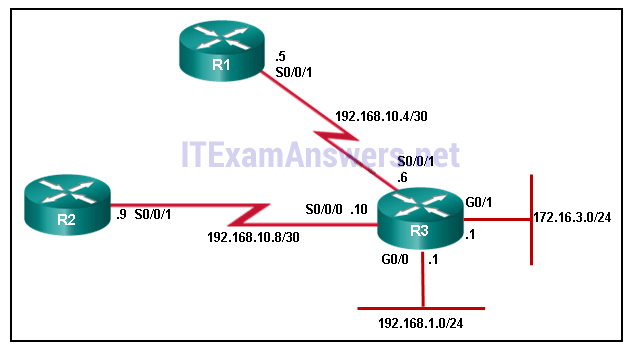 Correct
Correct
Incorrect
Hint
As a result of implementing EIGRP automatic summarization, router R3 uses a classful network addressing scheme to group networks together based on their classful network mask. 192.168.10.4/30 and 192.168.10.8/30 are shortened to 192.168.10.0/24 and 172.16.3.0/24 is summarized to 172.16.0.0/16. 192.168.1.0/24 is already using its classful mask and is not summarized. -
Question 14 of 115
14. Question
1 pointsRefer to the exhibit. Which two routes will be advertised to the router ISP if autosummarization is disabled? (Choose two.)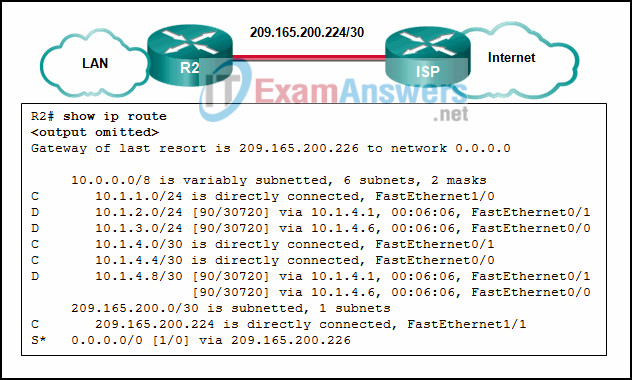 Correct
Correct
Incorrect
Hint
If the no auto-summary command was issued disabling the autosummarization, all subnetworks will be advertised, without summarization. -
Question 15 of 115
15. Question
1 pointsWhich is a characteristic of policy based routing (PBR)?Correct
Incorrect
-
Question 16 of 115
16. Question
1 pointsWhich two statements are true of policy-based routing (PBR) as a path control tool? (Choose two.)Correct
Incorrect
-
Question 17 of 115
17. Question
1 pointsA network administrator is writing a standard ACL that will deny any traffic from the 172.16.0.0/16 network, but permit all other traffic. Which two commands should be used? (Choose two.)Correct
Incorrect
Hint
To deny traffic from the 172.16.0.0/16 network, the access-list 95 deny 172.16.0.0 0.0.255.255 command is used. To permit all other traffic, the access-list 95 permit any statement is added. -
Question 18 of 115
18. Question
1 pointsRefer to the exhibit. Considering that R2, R3, and R4 are correctly configured, why did R1 not establish an adjacency with R2, R3, and R4?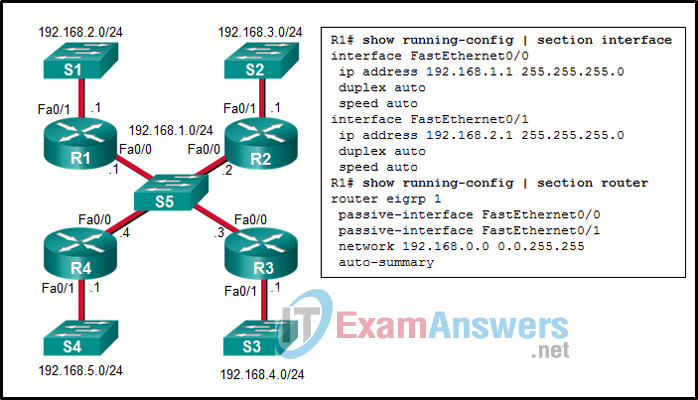 Correct
Correct
Incorrect
Hint
The missing routes are the result of there not being an EIGRP adjacency between R1 and R2, R3, and R4.To establish adjacency, a router must send and receive hello packets over an interface to and from its neighbors. The interface Fa0/ of the router R1 is declared as passive, so R1 will not send hello packets over its interface Fa0/0. -
Question 19 of 115
19. Question
1 pointsRefer to the exhibit. Routers R1 and R2 were configured with EIGRP message authentication, but the routers cannot exchange EIGRP messages. Which two problems are causing the EIGRP authentication failure between R1 and R2 in this configuration? (Choose two.)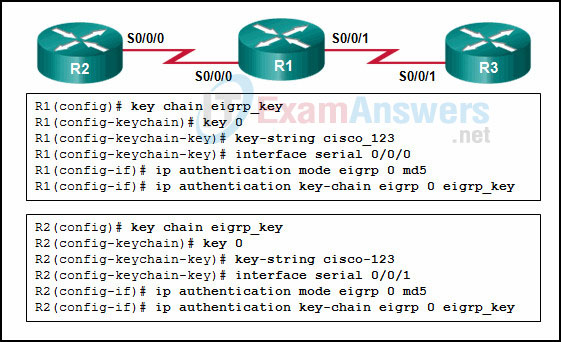 Correct
Correct
Incorrect
-
Question 20 of 115
20. Question
1 pointsRefer to the exhibit. Why did R1 and R2 not establish an adjacency?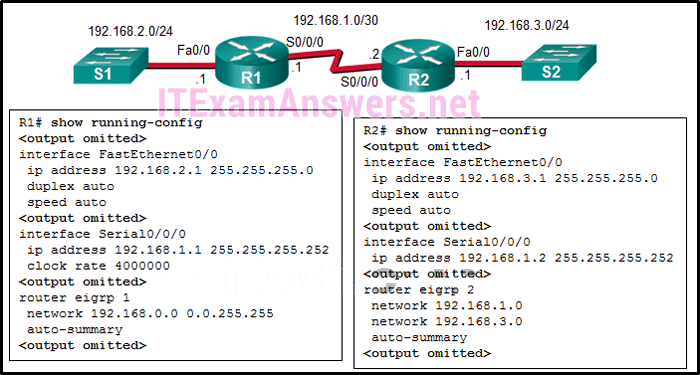 Correct
Correct
Incorrect
Hint
To establish adjacency, both routers must be configured with the same AS number. The network 192.168.0.0 .0.0.255.255 command issued on R1 includes all networks from 192.168.0.0 to 192.168.255.255. Therefore, the network 192.168.1.0/24 is also included. -
Question 21 of 115
21. Question
1 pointsMatch the IPsec function with its description. (Not all options are used.)Correct
Incorrect
-
Question 22 of 115
22. Question
1 pointsMatch the IPsec function with the description.Correct
Incorrect
-
Question 23 of 115
23. Question
1 pointsWhich three statements describe the IPsec protocol framework? (Choose three.)Correct
Incorrect
Hint
The two primary protocols used with IPsec are AH and ESP. AH is protocol number 51 and provides data authentication and integrity for IP packets that are exchanged between the peers. ESP, which is protocol number 50, performs packet encryption. -
Question 24 of 115
24. Question
1 pointsA network administrator is configuring an ACL to match networks for BGP route filtering. The administrator creates an ACE permit ip 10.0.32.0 0.0.31.0 255.255.255.0 0.0.0.192 . Which network matches the ACE?Correct
Incorrect
Hint
One method for conditional matching of routes in BGP is through extended ACLs. When extended ACLs are used for this purpose, the source fields match against the network portion of the route, and the destination fields match against the network mask. The network portion of the matching networks is 10.0.32.0 through 10.0.63.0. The network mask portion is /24 through /26. -
Question 25 of 115
25. Question
1 pointsRefer to the exhibit. A network administrator is troubleshooting BGP configuration and wants to display only routes that originated in AS 40. Which regular expression should the administrator use in the command show bgp ipv4 unicast regex regex-pattern ?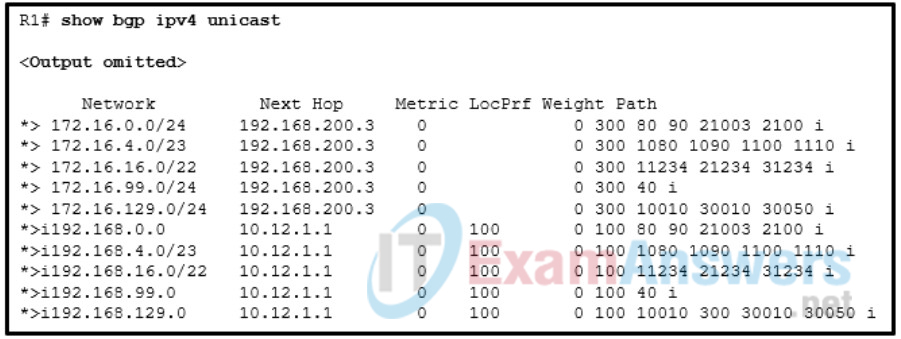 Correct
Correct
Incorrect
Hint
In troubleshooting BGP, regular expressions (regex) can be used to parse through the large number of available ASNs. Regular expressions are based on query modifiers used to select the appropriate content. The regex pattern 100_ indicates to only include the lines that contain the exact phrase of 100. Some regex query modifiers are as follows:- (underscore) – Matches a space
- ^ (caret) – Indicates the start of a string
- $ (dollar sign) – Indicates the end of a string
- . (period) – Matches a single character, including a space
-
Question 26 of 115
26. Question
1 pointsRefer to the exhibit. A network administrator issues theshow bgp ipv4 unicast 172.16.0.0command to check the route information in the BGP table. Which statement describes the characteristic of the advertisement of this route? Correct
Correct
Incorrect
-
Question 27 of 115
27. Question
1 pointsWhat OSPF LSA type is used to advertise routes redistributed into an OSPF domain?Correct
Incorrect
Hint
OSPF uses six LSA types for IPv4 routing:- Type 1, router: LSAs that advertise network prefixes within an area
- Type 2, network: LSAs that indicate the routers attached to broadcast segment within an area
- Type 3, summary: LSAs that advertises network prefixes that originate from a different area
- Type 4, ASBR summary: LSA used to locate the ASBR from a different area
- Type 5, AS external: LSA that advertises network prefixes that were redistributed in to OSPF
- Type 7, NSSA external: LSA for external network prefixes that were redistributed in a local NSSA area
-
Question 28 of 115
28. Question
1 pointsRefer to the exhibit. A network administrator has configured two-way redistribution on router R1. What metrics will be used for redistributed routes?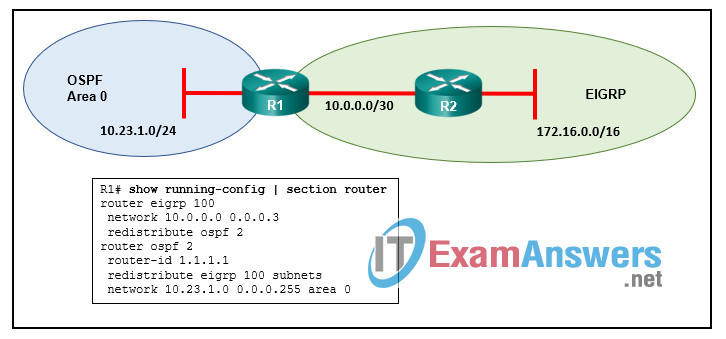 Correct
Correct
Incorrect
-
Question 29 of 115
29. Question
1 pointsRefer to the exhibit. Which route will appear in the routing table of R3 as a result of the redistribution configuration issued on R2?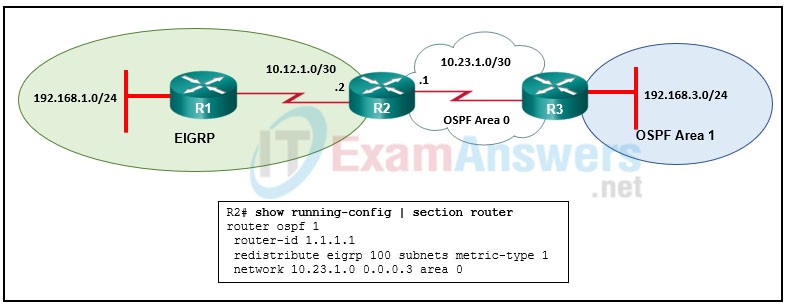 Correct
Correct
Incorrect
-
Question 30 of 115
30. Question
1 pointsRefer to the exhibit. A network administrator has configured OSPFv2 on the two Cisco routers. The routers are unable to form a neighbor adjacency. What should be done to fix the problem on router R2?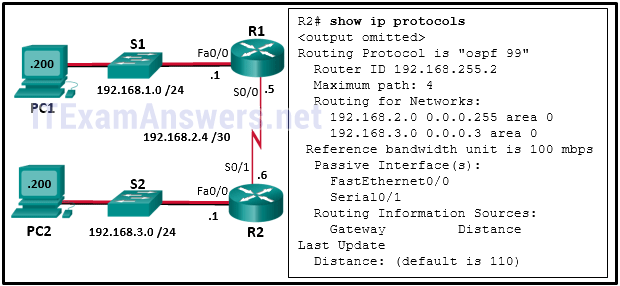 Correct
Correct
Incorrect
-
Question 31 of 115
31. Question
1 pointsRefer to the exhibit. A network administrator is troubleshooting a recent OSPF stub configuration between R3 and R4. The only routes that should appear on the routing table for R4 are intra-area routes and the default route. However, interarea routes are also appearing. What must the administrator do to fix this problem?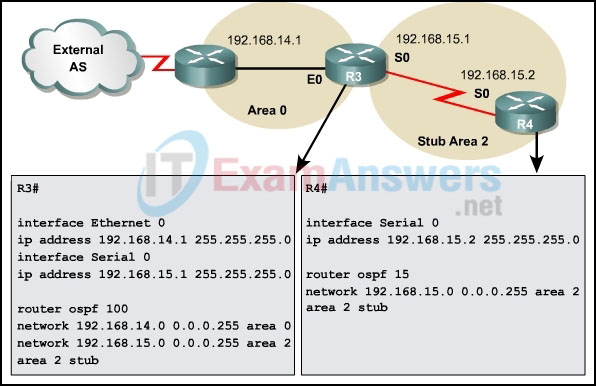 Correct
Correct
Incorrect
-
Question 32 of 115
32. Question
1 pointsRefer to the exhibit. Router R0-A is not learning all of the OSPF routes from the remote sites that connect to router R0-B and R0-C. What are two issues the network engineer should consider? (Choose two.)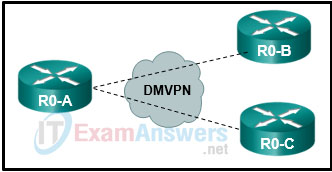 Correct
Correct
Incorrect
-
Question 33 of 115
33. Question
1 pointsRefer to the exhibit. Routers R1 and R2 are configured as shown. However, theshow ipv6 ospf neighborcommand reveals that there are no OSPFv3 neighbors established. What error in the configuration is preventing neighbor relationship from forming between the two routers?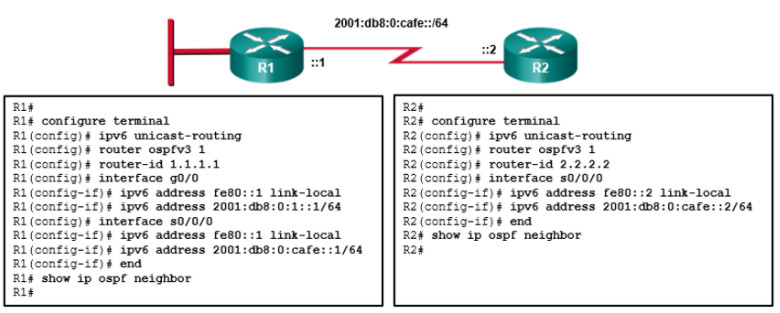 Correct
Correct
Incorrect
Hint
The routers are unable to form an OSPFv3 adjacency because OSPFv3 has not been enabled on the interfaces with theospfv3 1 ipv6 area 0command. -
Question 34 of 115
34. Question
1 pointsRefer to the exhibit. An administrator has entered the command default-information originate in OSPFv3 global configuration mode on R1, but R2 is not receiving a default route. What is the problem?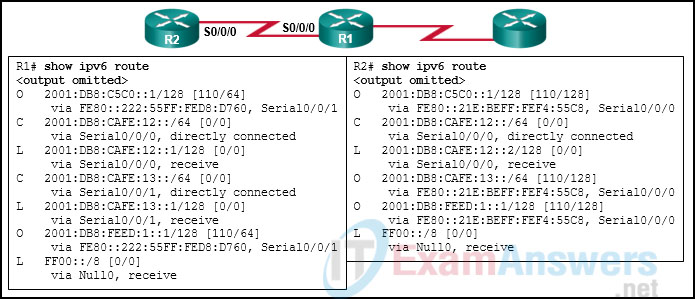 Correct
Correct
Incorrect
-
Question 35 of 115
35. Question
1 pointsAn administrator is troubleshooting an OSPFv3 network. Router A and router B are configured with IPv6 addressing and basic routing capabilities using OSPFv3. While debugging the routing process, the administrator discovers that the networks that are advertised from router A do not show in the routing table of router B. Why is the routing information not being learned by router B?Correct
Incorrect
-
Question 36 of 115
36. Question
1 pointsRefer to the exhibit. Routers R1 and R2 enable EIGRP on all of their interfaces. Which two conclusions can the field engineer draw from the outputs of the show ip route eigrp command on each router? (Choose two.)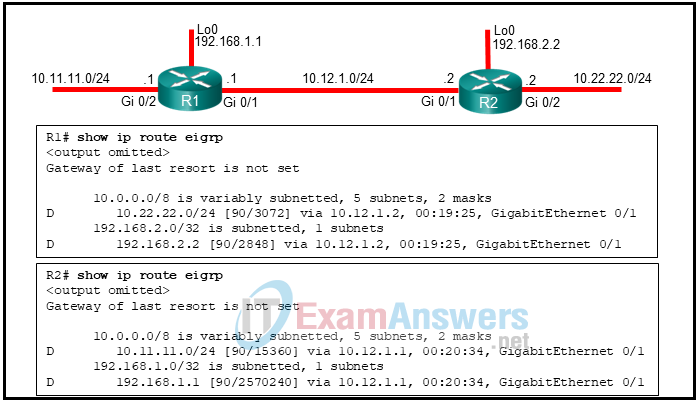 Correct
Correct
Incorrect
Hint
The metrics for R2 routes are different from the metrics from R1 routes. This is because R1 is using EIGRP classic configuration mode that uses classic metrics, and R2 is using EIGRP named mode configuration that uses wide metrics by default. The EIGRP classic metric calculation uses 5 K values (K1 to K5) to calculate the metric, whereas the EIGRP wide metric calculation uses 6 K values (K1 to K6). The two metric styles will allow adjacency between the two routers, as long as K1 through K5 are the same, and K6 is not set. The wide metrics calculation addresses the issues of scalability with higher-capacity interfaces. -
Question 37 of 115
37. Question
1 pointsRefer to the exhibit. An administrator wants EIGRP on Router1 to load balance traffic to network 2001:db8:11:10::/64 across two interfaces. Currently traffic is using only interface GigabitEthernet0/1. A second route, not in the routing table, is available with a metric of 264000. What value is needed in the variance command to make EIGRP put the second route into the routing table?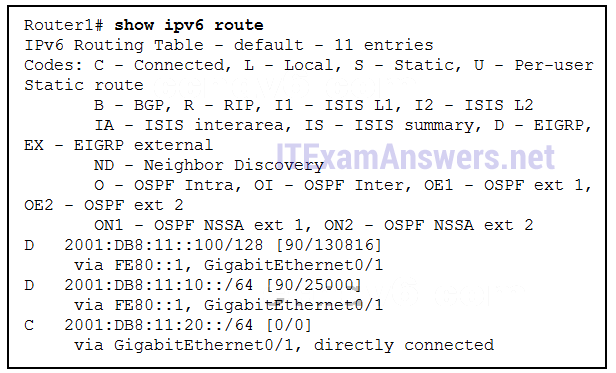 Correct
Correct
Incorrect
Hint
A variance of 11 is needed to load balance across the second route. The metric of the existing successor route is 25000. The metric of the second route is 264000. The first metric needs to be multiplied by 11, which is 275000, in order for the route to be put into the routing table. -
Question 38 of 115
38. Question
1 pointsRefer to the exhibit. Router R2 has recently been configured and connected via interface Gigabit Ethernet 0/0 to router R1. R1 is configured correctly, but fails to establish a neighbor relationship with R2. What is the problem?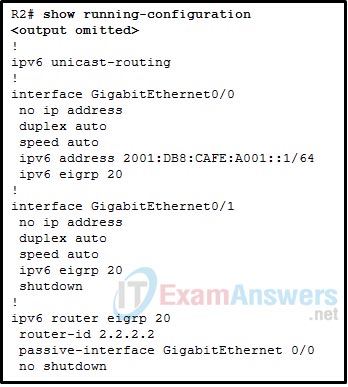 Correct
Correct
Incorrect
-
Question 39 of 115
39. Question
1 pointsAn administrator wants to configure EIGRPv6 in an IPv6 network. Which three statements are valid for the configuration of EIGRPv6? (Choose three.)Correct
Incorrect
-
Question 40 of 115
40. Question
1 pointsRefer to the exhibit. A network administrator configured a class map as shown, but the traffic is not being classified as desired. Which conclusion can be drawn from this configuration?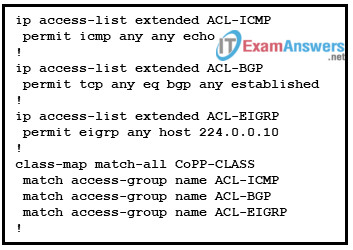 Correct
Correct
Incorrect
Hint
A class map may contain one of two instructions: match-any or match-all . If you have multiple match commands in a single class map and match-any is used, it means the traffic must match one of the match commands to be classified as part of the traffic class. If you use match-all , the traffic must match all the match commands to be part of the traffic class. Considering the exhibit, it is not possible for a packet to be ICMP, BGP, and EIGRP at the same time. Therefore, the traffic would never match the CoPP-CLASS class map and would never be subject to the implicit default class. -
Question 41 of 115
41. Question
1 pointsRefer to the exhibit. A network administrator configures AAA authentication on router R1. The ACS servers are configured and running. The administrator tests the configuration by telneting to R1. What will happen if the administrator attempts to authenticate through the RADIUS server using incorrect credentials?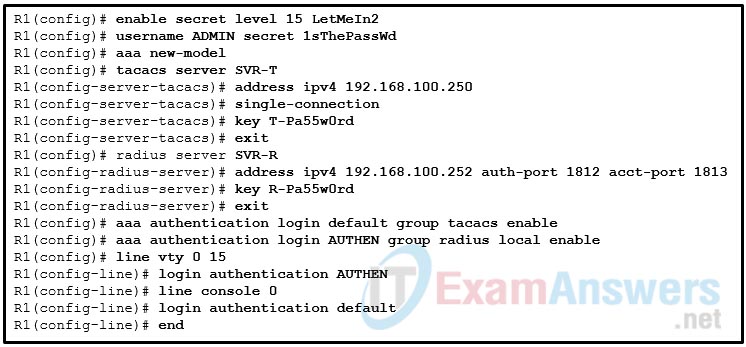 Correct
Correct
Incorrect
Hint
The authentication for Telnet connections is defined by AAA method list AUTHEN. The AUTHEN list defines that the first authentication method is through an ACS server using the RADIUS protocol (or RADIUS server), the second authentication method is to use the local user database, and the third method is to use the enable password. In this scenario, however, because the administrator fails to pass the authentication by the first method, the authentication process stops and no other authentication methods are allowed. -
Question 42 of 115
42. Question
1 pointsRefer to the exhibit. A network administrator issues the show run | section username|aaa|line|radius command to verify an AAA configuration on a Cisco router. Which two conclusions can be drawn from the command output? (Choose two.)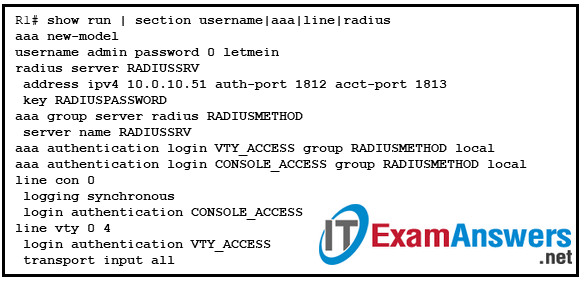 Correct
Correct
Incorrect
Hint
The conclusions that can be drawn from the command output are: According to the aaa authentication login VTY_ACCESS group RADIUSMETHOD local command the first method to be used is the group of servers in the RADIUSMETHOD group. According to the aaa authentication login CONSOLE_ACCESS group RADIUSMETHOD local command, the first method to be used is the group of servers in the RADIUSMETHOD group, and the second method to be used if the servers are not available is the local username and password database. RADIUS server is using ports 1812 and 1813 for authentication and accounting, so the port numbers on the Cisco router should be the same, not the Cisco default ports (1645 and 1646). The router needs to be configured with the same pre-shared key for the RADIUS server, RADIUSPASSWORD . When a router sources packets, it uses the exit interface as the source of the packet. If the exit interface is not configured with the IP address that the AAA server is expecting, the client cannot use the AAA server and the services it provides. It is recommended that the IP address of a loopback interface be used for the source of packets and as the client IP address that is configured on the AAA server. Therefore, the router should be configured with the ip radius source-interface [ loopback ] [ number ]. -
Question 43 of 115
43. Question
1 pointsFrom the routing tables shown from routers within a multiarea OSPF network, which routing table would be from an internal router that is within a totally stub area? A.Gateway of last resort is 10.1.1.1 to network 0.0.0.0 10.0.0.0/8 is variably subnetted, 8 subnets, 4 masks O IA 10.0.0.0/30 [110/4] via 10.1.1.1, 01:17:40, GigabitEthernet0/1 O IA 10.0.0.4/30 [110/3] via 10.1.1.1, 01:17:50, GigabitEthernet0/1 O IA 10.0.0.8/30 [110/66] via 10.1.1.1, 01:17:50, GigabitEthernet0/1 O 10.1.0.0/24 [110/2] via 10.1.1.1, 01:18:00, GigabitEthernet0/1 C 10.1.1.0/24 is directly connected, GigabitEthernet0/1 L 10.1.1.2/32 is directly connected, GigabitEthernet0/1 O IA 10.2.0.0/25 [110/5] via 10.1.1.1, 01:17:40, GigabitEthernet0/1 O IA 10.2.0.128/25 [110/6] via 10.1.1.1, 01:17:40, GigabitEthernet0/1 O*IA 0.0.0.0/0 [110/3] via 10.1.1.1, 01:17:50, GigabitEthernet0/1
B.Gateway of last resort is 10.1.1.1 to network 0.0.0.0 10.0.0.0/8 is variably subnetted, 3 subnets, 2 masks O 10.1.0.0/24 [110/2] via 10.1.1.1, 01:26:37, GigabitEthernet0/1 C 10.1.1.0/24 is directly connected, GigabitEthernet0/1 L 10.1.1.2/32 is directly connected, GigabitEthernet0/1 O*IA 0.0.0.0/0 [110/3] via 10.1.1.1, 01:26:27, GigabitEthernet0/1
C.Gateway of last resort is 10.0.0.5 to network 0.0.0.0 10.0.0.0/8 is variably subnetted, 10 subnets, 4 masks O 10.0.0.0/30 [110/2] via 10.0.0.5, 01:42:33, GigabitEthernet0/1 C 10.0.0.4/30 is directly connected, GigabitEthernet0/1 L 10.0.0.6/32 is directly connected, GigabitEthernet0/1 C 10.0.0.8/30 is directly connected, Serial0/0/0 L 10.0.0.9/32 is directly connected, Serial0/0/0 C 10.1.0.0/24 is directly connected, GigabitEthernet0/0 L 10.1.0.1/32 is directly connected, GigabitEthernet0/0 O 10.1.1.0/24 [110/2] via 10.1.0.2, 01:42:38, GigabitEthernet0/0 O IA 10.2.0.0/25 [110/3] via 10.0.0.5, 01:42:33, GigabitEthernet0/1 O IA 10.2.0.128/25 [110/4] via 10.0.0.5, 01:42:33, GigabitEthernet0/1 192.168.0.0/24 is variably subnetted, 2 subnets, 2 masks O E2 192.168.0.0/30 [110/20] via 10.0.0.5, 01:42:33, GigabitEthernet0/1 O E2 192.168.0.64/26 [110/20] via 10.0.0.5, 00:47:20, GigabitEthernet0/1 O*E2 0.0.0.0/0 [110/1] via 10.0.0.5, 01:42:33, GigabitEthernet0/1
D.Gateway of last resort is not set 1.0.0.0/32 is subnetted, 1 subnets C 1.1.1.1/32 is directly connected, Loopback0 S 10.0.0.0/8 is directly connected, Serial0/0/0 203.0.113.0/24 is variably subnetted, 2 subnets, 2 masks C 203.0.113.0/30 is directly connected, Serial0/0/0 L 203.0.113.1/32 is directly connected, Serial0/0/0
Correct
Incorrect
-
Question 44 of 115
44. Question
1 pointsHow does Cisco implement interarea OSPF summarization?Correct
Incorrect
-
Question 45 of 115
45. Question
1 pointsWhat are the two purposes of an OSPF router ID? (Choose two.)Correct
Incorrect
Hint
OSPF router ID does not contribute to SPF algorithm calculations, nor does it facilitate the transition of the OSPF neighbor state to Full. Although the router ID is contained within OSPF messages when router adjacencies are being established, it has no bearing on the actual convergence process. -
Question 46 of 115
46. Question
1 pointsHow is the flooding scope of link state advertisements denoted within OSPFv3 LSAs?Correct
Incorrect
-
Question 47 of 115
47. Question
1 pointsA network technician is verifying the OPSFv3 address families configuration on a Cisco router. What would the technician expect to see displayed when the show ospfv3 database router adv-router 4.4.4.4 command is issued?Correct
Incorrect
-
Question 48 of 115
48. Question
1 pointsRefer to the exhibit. Both routers R1 and R2 are configured for OSPFv3 and are routing for both IPv4 and IPv6 address families. Which two destination addresses will R1 use to establish a full adjacency with R2? (Choose two.)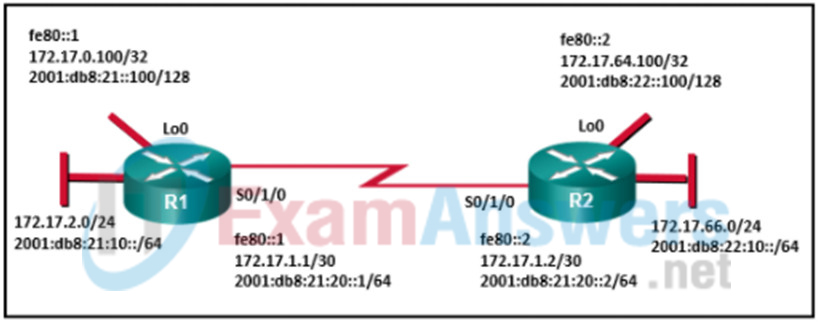 Correct
Correct
Incorrect
-
Question 49 of 115
49. Question
1 pointsRefer to the exhibit. Router R1 was configured by a network administrator to use SNMP version 2. The following commands were issued: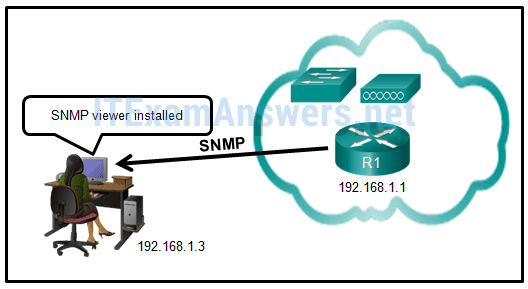
R1(config)# snmp-server community batonaug ro SNMP_ACL R1(config)# snmp-server contact Wayne World R1(config)# snmp-server host 192.168.1.3 version 2c batonaug R1(config)# ip access-list standard SNMP_ACL R1(config-std-nacl)# permit 192.168.10.3
Why is the administrator not able to get any information from R1?Correct
Incorrect
Hint
The permit statement with the incorrect IP address is the reason why the administrator is not able to access router R1. The correct statement should be permit 192.168.1.3. The snmp-server location and snmp-server enable traps commands are optional commands and have no relation to the access restriction to router R1. The rw keyword does not need to be included in this case because the administrator just wants to obtain information, not change any configuration. -
Question 50 of 115
50. Question
1 pointsRefer to the exhibit. The total number of packet flows is not consistent with what is expected by the network administrator. The results show only half of the flows that are typically captured for the interface. Pings between the router and the collector are successful. What is the reason for the unexpected results?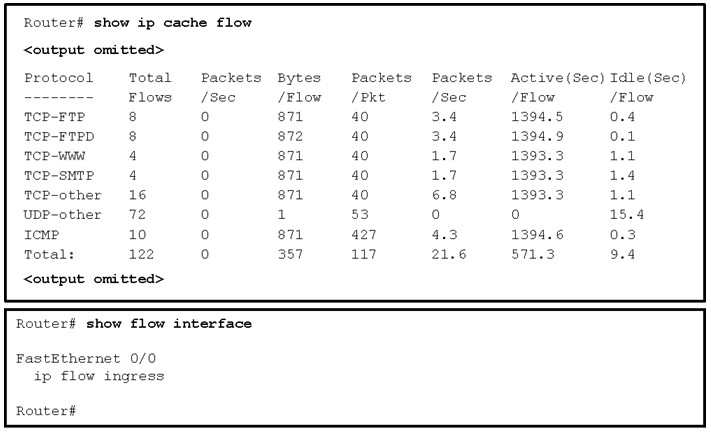 Correct
Correct
Incorrect
Hint
NetFlow flows are unidirectional. One user connection exists as two flows. The flow in each direction must be captured. This is done by using both the ip flow ingress and ip flow egress command on the interface. -
Question 51 of 115
51. Question
1 pointsRefer to the exhibit. A network administrator is configuring the syslog service on a Cisco router. Which command should be used to configure an IPv4 address of 192.168.10.254 as the source address on the syslog packets as they exit the router R1?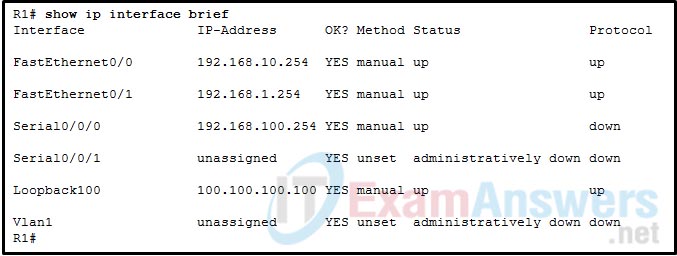 Correct
Correct
Incorrect
-
Question 52 of 115
52. Question
1 pointsWhich three implicit access control entries are automatically added to the end of an IPv6 ACL? (Choose three.)Correct
Incorrect
-
Question 53 of 115
53. Question
1 pointsWhich two networks would match the following prefix list? (Choose two.)ip prefix-list MATCHTHIS seq 5 deny 10.1.0.0/16 ge 24 le 30
Correct
Incorrect
-
Question 54 of 115
54. Question
1 pointsRefer to the exhibit. An administrator has configured the IPv6 ACL that is in the exhibit to permit outbound Telnet traffic to any destination, and block TCP connections from 2001:db8:1::1 to any destination. All other packets should be denied and logged. After implementing the ACL, all IPv6 traffic, including Telnet from the 2001:db8::/32 subnet is denied. What is the problem? Correct
Correct
Incorrect
-
Question 55 of 115
55. Question
1 pointsRefer to the exhibit. A network administrator issues the commandshow bgp ipv6 unicast | begin Networkto check the BGP table. Which statement describes the routes with an unspecified address (::) in the Next Hop column? Correct
Correct
Incorrect
Hint
An unspecified address in the BGP table indicates that the local router is generating the prefix for the BGP table. The weight value 32,768 also indicates that the prefix is locally originated by the router. -
Question 56 of 115
56. Question
1 pointsRefer to the exhibit. A network administrator issues the show bgp ipv4 unicast 10.1.1.128 command on router R2 to verify the network 10.1.1.128 in the BGP table. The administrator notices that there are two paths to reach the network. Which BGP factor is used to determine the best-path?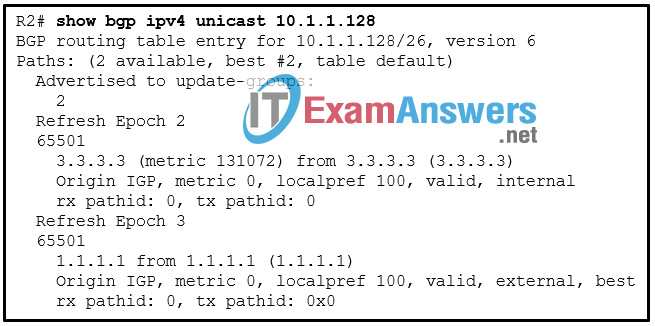 Correct
Correct
Incorrect
Hint
Cisco routers review BGP attributes in the following ranked order when deciding which path is the best-path:- – Prefer the highest weight .
- – Prefer the highest local preference .
- – Prefer the route originated by the local router.
- – Prefer the path with the shorter Accumulated Interior Gateway Protocol (AIGP) metric attribute.
- – Prefer the shortest AS_Path .
- – Prefer the lowest origin code.
- – Prefer the lowest multi-exit discriminator (MED).
- – Prefer an external path over an internal path.
- – Prefer the path through the closest IGP neighbor .
- – Prefer the oldest route for EBGP paths.
- – Prefer the path with the lowest neighbor BGP RID .
- – Prefer the path with the lowest neighbor IP address .
-
Question 57 of 115
57. Question
1 pointsRefer to the exhibit. A network administrator is configuring BGP route advertisement on router R1. The network 10.1.0.0/24 is subnetted into four 10.1.0.0/26 subnets that are attached to the 4 interfaces of R1 respectively. The administrator issues the show ip route command and notices that the network 10.1.0.0/24 is not advertised by BGP. What is a possible cause for this issue?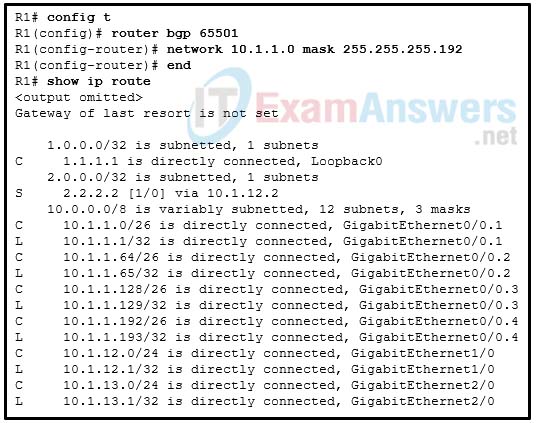 Correct
Correct
Incorrect
-
Question 58 of 115
58. Question
1 pointsRefer to the exhibit. Which protocol is used by R2 and R5 to exchange Layer 3 routes? Correct
Correct
Incorrect
-
Question 59 of 115
59. Question
1 pointsWhen an unlabeled packet arrives at an MPLS-enabled router interface, which database is used to make a forwarding decision on the packet?Correct
Incorrect
-
Question 60 of 115
60. Question
1 pointsMatch the MPLS router type to its characteristic.Correct
Incorrect
-
Question 61 of 115
61. Question
1 pointsWhat is the order in determining the BGP router ID?Correct
Incorrect
Hint
Statically configuring the BGP router ID (RID) is a best practice to ensure RID stability. If the RID is not statically configured, the dynamic RID allocation logic uses the highest IP address of any active loopback interfaces. If there is not an active loopback interface, then the highest IP address of any active interfaces becomes the RID when the BGP process initializes. -
Question 62 of 115
62. Question
1 pointsA network engineer is troubleshooting OSPFv2 routing issues on two connected routers. Which two requirements to form an adjacency need to be verified? (Choose two.)Correct
Incorrect
Hint
The OSPFv2 process ID is local to each router and does not have to be common. Neither interface on the link connecting the two routers can be passive. Both must be participating in the OSPF area. The DR, BDR, and DROTHER status of the router has no bearing on the adjacency relationship. -
Question 63 of 115
63. Question
1 pointsRouter RTRA is adjacent to RTRB through a WAN link. RTRB can be seen in the output of the show cdp neighbors command issued on RTRA, can be pinged from RTRA, but is not showing OSPF routes from RTRA. What are two potential issues? (Choose two.)Correct
Incorrect
Hint
The fact that RTRB can be pinged from RTRA indicates that there is connectivity between the two routers. However, the absence of OSPF routes from RTRA suggests that there is a configuration issue. One potential issue is that one or both routers are missing or have a misconfigured network statement for the OSPF process. OSPF relies on routers to advertise the networks they are connected to by including them in the OSPF domain through the use of network statements. If these statements are missing or misconfigured, the routers will not advertise their networks and OSPF routes will not be available. Another potential issue is that a distribute list is denying routes from being installed in the routing table. Distribute lists can be used to filter incoming and outgoing OSPF routes based on certain criteria such as prefix, access list, or prefix list. If a distribute list is configured to deny routes from being installed in the routing table, OSPF routes from RTRB may not be available on RTRA. -
Question 64 of 115
64. Question
1 pointsRefer to the exhibit. A network administrator is configuring a GRE tunnel between two corporate sites terminating on routers CE1 and CE2. The router CE2 is already configured. What set of commands should the administrator configure on router CE1? Correct
Correct
Incorrect
-
Question 65 of 115
65. Question
1 pointsRefer to the exhibit. What is the function of the Null0 route in the outputs displayed for R1 and R2?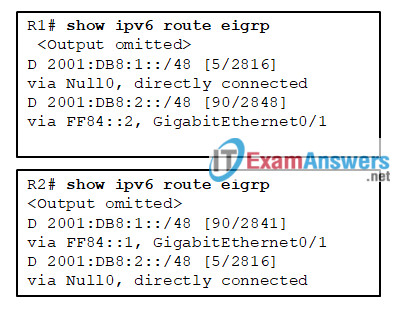 Correct
Correct
Incorrect
Hint
In EIGRPv6, a Null0 route with an administrative distance of 5 is added to the routing table as a loop-prevention mechanism. Only the /48 summary prefix is received from the neighbor router and any of the more specific /64 and /128 route entries are suppressed. In this instance a Null0 route is populated on the router for the local /48 summary route advertisement. -
Question 66 of 115
66. Question
1 pointsRefer to the exhibit. A network administrator issues the show ipv6 eigrp neighbors command. Which conclusion can be drawn based on the output? Correct
Correct
Incorrect
-
Question 67 of 115
67. Question
1 pointsWhich ACE will permit a packet that originates from any network and is destined for a web server at 192.168.1.1?Correct
Incorrect
-
Question 68 of 115
68. Question
1 pointsAn administrator is troubleshooting two routers in an OSPFv3 network. They are trying to establish an OSPFv3 adjacency over an Ethernet link, but the adjacency is not forming. What are two possible reasons for this issue? (Choose two.)Correct
Incorrect
Hint
When troubleshooting OSPFv3 adjacency issues between two routers over an Ethernet link, the following issues could be the possible reasons for adjacency failure:- Mismatched network types: OSPFv3 supports different network types such as broadcast, non-broadcast, point-to-point, and point-to-multipoint. Both routers should have the same OSPFv3 network type configured on the Ethernet interface for adjacency to form.
- Mismatched link-local addresses: OSPFv3 uses link-local addresses to establish an adjacency between two routers over an Ethernet link. If the link-local addresses on both routers are not configured correctly, the adjacency will not form.
-
Question 69 of 115
69. Question
1 pointsRefer to the exhibit. R1 and R2 are connected to the same LAN segment and are configured to run OSPFv3. They are not forming a neighbor adjacency. What is the cause of the problem?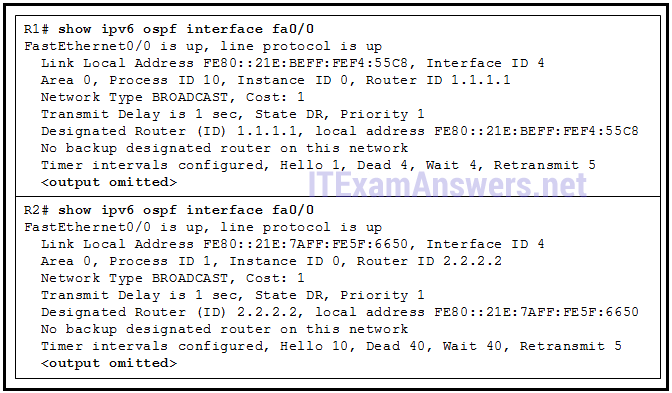 Correct
Correct
Incorrect
Hint
There is a mismatch between the timer intervals of R1 and R2. In OSPF the timers must match on two routers before they will become neighbors. The IPv6 addresses that are used by OSPFv3 are link-local, and are in the same subnet. The OSPFv3 process ID is locally significant, and does not have to match between routers. The default OSPF interface priority value is 1, and does not prevent neighbor relationships from forming. -
Question 70 of 115
70. Question
1 pointsRefer to the exhibit. A SNMP manager is using the community string of snmpenable and is configured with the IP address 172.16.10.1. The SNMP manager is unable to read configuration variables on the R1 SNMP agent. What could be the problem?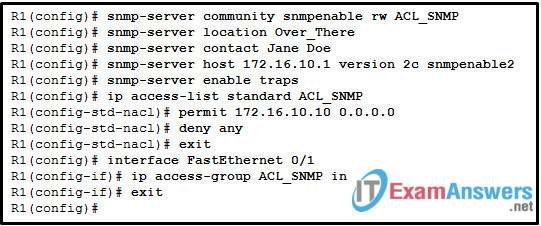 Correct
Correct
Incorrect
Hint
ACLs are used to prevent SNMP messages from going beyond the required devices. The ACL_SNMP is permitting only the host IP of 172.16.10.10 to access the SNMP agent. The actual IP of the SNMP manager is 172.16.10.1. The SNMP agent is configured for read-write access for reading and setting variables. The community string of snmpenable2 is only affecting connectivity for trap messages. -
Question 71 of 115
71. Question
1 pointsIn which two situations would a company consider using an OSPF virtual link? (Choose two.)Correct
Incorrect
Hint
An OSPF virtual link is used to connect two areas through a non-backbone area. The virtual link is used to overcome the discontiguity of the OSPF domain caused by the non-backbone area. Therefore, it would be appropriate to use an OSPF virtual link in the following two situations:- When connecting discontiguous areas: If there are two OSPF areas that are not physically connected to each other, a virtual link can be created to connect them. The virtual link passes through a non-backbone area to reach the destination area.
- When merging with another company and needing to connect the two backbone areas: If two companies merge, and each has its own OSPF backbone area, a virtual link can be created to connect the two backbone areas. This allows for a seamless integration of the two OSPF domains.
-
Question 72 of 115
72. Question
1 pointsRefer to the exhibit. A network administrator verifies on an enterprise network that EIGRP query packets are delayed because of packet loss. The administrator issues the show ip protocols | include Active command to see the EIGRP active timer on a router. What can the administrator conclude from this output? Correct
Correct
Incorrect
Hint
Occasionally, an EIGRP query is delayed because of packet loss, slow neighbors, or a large hop count. EIGRP maintains an active timer, which has a default value of 3 minutes (180 seconds). According to the output, the active timer was set to 2 minutes (120 seconds). EIGRP then waits half of the active timer value that was set (60 seconds) for a reply. If the router does not receive a response within 60 seconds, the originating router sends a SIA query to EIGRP neighbors that did not respond. -
Question 73 of 115
73. Question
1 pointsRefer to the exhibit. A network engineer is troubleshooting a configuration for EIGRP and OSPF mutual redistribution. Why is the OSPF process not receiving all of the redistributed EIGRP routes?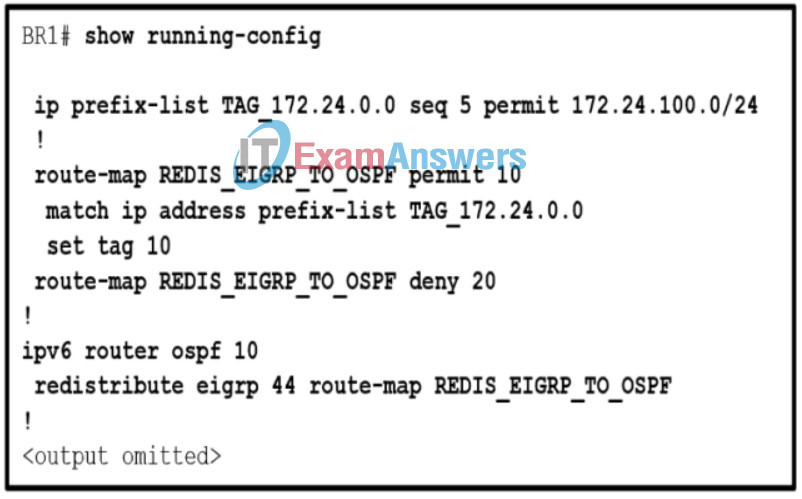 Correct
Correct
Incorrect
-
Question 74 of 115
74. Question
1 pointsRefer to the exhibit. A network administrator has attempted to implement a default route from R1 to the ISP and propagate the default route to EIGRP neighbors. Remote connectivity from the EIGRP neighbor routers to the ISP connected to R1 is failing. Based on the output from the exhibit, what is the most likely cause of the problem?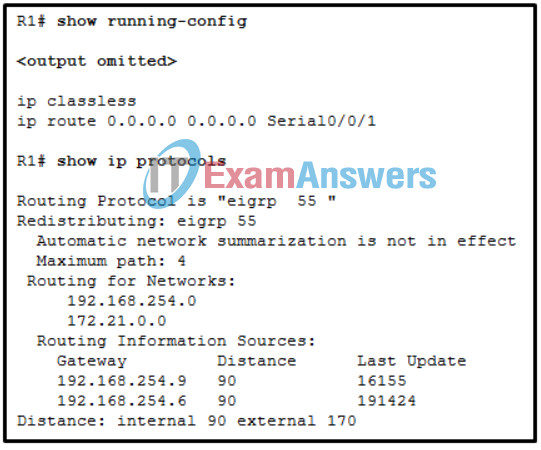 Correct
Correct
Incorrect
-
Question 75 of 115
75. Question
1 pointsWhich two network prefixes match the prefix match pattern 172.16.0.0/12 ge 16? (Choose two.)Correct
Incorrect
-
Question 76 of 115
76. Question
1 pointsWhat is the purpose of the BGP maximum prefix feature?Correct
Incorrect
Hint
The BGP maximum prefix feature restricts the number of routes that are received from a BGP peer. -
Question 77 of 115
77. Question
1 pointsWhat is the purpose of the BGP maximum prefix feature?Correct
Incorrect
Hint
The BGP (Border Gateway Protocol) maximum prefix feature is used to limit the number of BGP prefixes that a router will accept from a specific peer. The purpose of this feature is to prevent the router from being overwhelmed with too many prefixes, which could cause the router to run out of memory or processing resources. By setting a maximum prefix limit, the router can protect itself from receiving an excessive number of BGP routes, which can be particularly important in cases where a misconfiguration or a routing loop can cause an uncontrolled growth in the number of prefixes being advertised. -
Question 78 of 115
78. Question
1 pointsRefer to the exhibit. Router R2 is configured for 2-way redistribution between OSPF and EIGRP. When the network administrator views the EIGRP topology table on R1, no redistributed routes from OSPF are present. What corrective action on R2 should the administrator take to resolve this issue?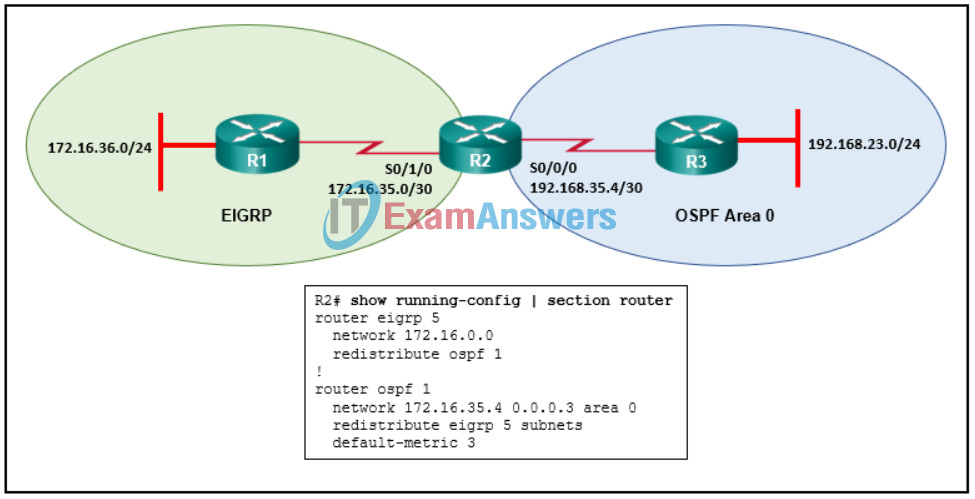 Correct
Correct
Incorrect
-
Question 79 of 115
79. Question
1 pointsWhich three statements describe the default operation of route redistribution? (Choose three.)Correct
Incorrect
Hint
Default redistribution behavior is as follows:- BGP only redistributes EBGP routes into IGP protocols.
- Routes redistributed into OSPF from BGP have a seed metric of 1.
- Routes redistributed into EIGRP have an AD of 170.
- Routes redistributed into OSPF have an AD of 110.
- The default BGP weight for redistributed routes is 32,768.
-
Question 80 of 115
80. Question
1 pointsWhich two elements of security are ensured by data integrity? (Choose two.)Correct
Incorrect
Hint
Data integrity ensures that data has not been modified or tampered with in transit or storage, and that it is accurate and consistent. This is typically achieved through the use of cryptographic techniques, such as digital signatures or hash functions. The following statements describe the elements of security that are ensured by data integrity:- Data is accurate and has not been changed in transit. By ensuring that data has not been modified or tampered with, data integrity ensures that data is accurate and that it has not been changed in transit.
- Data can only be modified by authorized users. Data integrity also ensures that data can only be modified by authorized users, who have the necessary permissions to modify the data. This helps to prevent unauthorized changes to data and helps to maintain the accuracy and consistency of data.
-
Question 81 of 115
81. Question
1 pointsWhich feature of IPsec validates the source of data transmitted through the Internet?Correct
Incorrect
Hint
Authentication is the process of verifying the identity of a sender or receiver of data, and ensuring that the data has not been tampered with in transit. IPsec provides authentication through the use of digital certificates or pre-shared keys, which allow the receiver to verify the identity of the sender. -
Question 82 of 115
82. Question
1 pointsWhat is used on PE routers in an MPLS Layer 3 VPN deployment to isolate the routes of multiple customers?Correct
Incorrect
-
Question 83 of 115
83. Question
1 pointsRefer to the exhibit. While configuring a multiarea OSPF topology, a network administrator implements the network 10.254.254.0 0.0.0.255 area 99 command. Which type of OSPF router is being configured?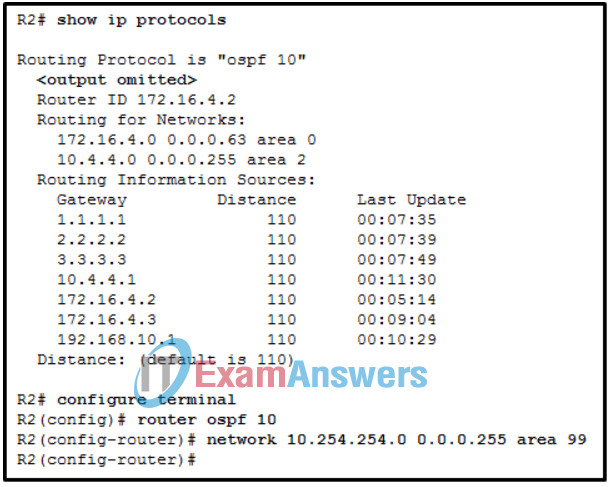 Correct
Correct
Incorrect
-
Question 84 of 115
84. Question
1 pointsA network administrator is configuring IPv6 route summarization on a BGP router with the command aggregate-address 2001:db8::/60 summary-only . Which two component networks match the aggregated route? (Choose two.)Correct
Incorrect
-
Question 85 of 115
85. Question
1 pointsIn addition to no shutdown , which two commands must a network technician issue on the interface of a Cisco router to enable OSPFv3 address families for IPv6 on that interface? (Choose two.)Correct
Incorrect
-
Question 86 of 115
86. Question
1 pointsWhich forwarding address is used by OSPFv3 address families learned routes to forward data packets to the next hop router?Correct
Incorrect
-
Question 87 of 115
87. Question
1 pointsWhich two classes of BGP path attributes are advertised between autonomous systems? (Choose two.)Correct
Incorrect
-
Question 88 of 115
88. Question
1 pointsMultiple paths exist in the BGP table. Assuming the weights are the same, what will the next determining factor be?Correct
Incorrect
-
Question 89 of 115
89. Question
1 pointsA network administrator issues the show bgp ipv4 unicast summary command on a router to check the adjacency state with a neighbor router. The value under the State/PfxRcd field shows Idle. Which statement describes the status of adjacency between the two routers?Correct
Incorrect
-
Question 90 of 115
90. Question
1 pointsRefer to the exhibit. A user has configured a NIC on the PC as shown but finds that the PC is unable to access the Internet. What is the problem?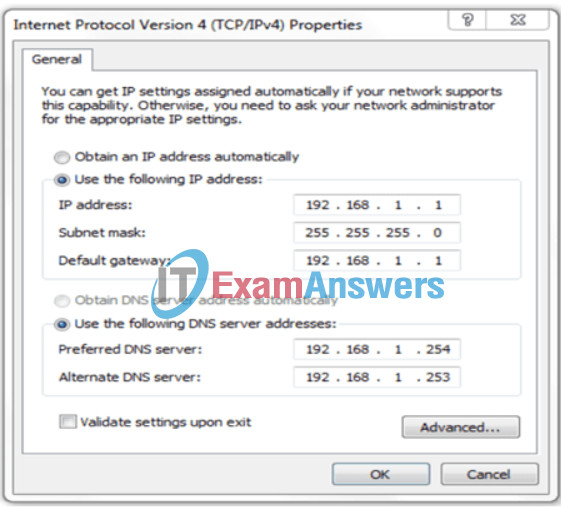 Correct
Correct
Incorrect
Hint
In order for a computer to communicate outside its network, it must have a valid default gateway configured.This address cannot be the same as the IP address of the computer. -
Question 91 of 115
91. Question
1 pointsRefer to the exhibit. For the given topology, what are three results of the OSPF DR and BDR elections ? (Choose three.)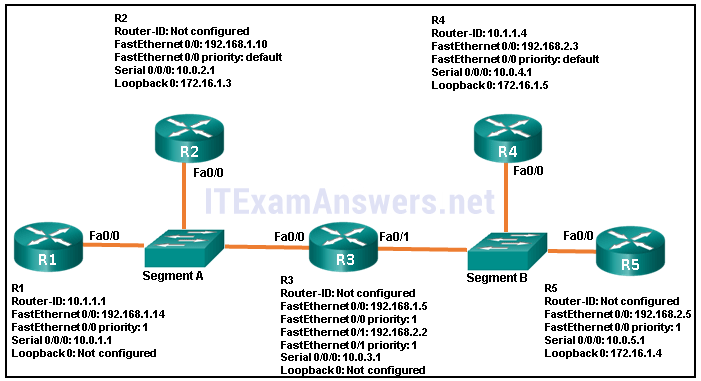 Correct
Correct
Incorrect
Hint
R3 will be elected DR for segment A because it has the highest router-ID of 192.168.1.5. R3 will be elected DR for segment B because it has the highest router-ID of 192.168.2.2. R5 will be elected BDR because it has the numerically highest router-ID of 172.16.1.4. -
Question 92 of 115
92. Question
1 pointsConsider the following access list that allows IP phone configuration file transfers from a particular host to a TFTP server:R1(config)# access-list 105 permit udp host 10.0.70.23 host 10.0.54.5 range 1024 5000 R1(config)# access-list 105 deny ip any any R1(config)# interface gi0/0 R1(config-if)# ip access-group 105 out
Which method would allow the network administrator to modify the ACL and include FTP transfers from any source IP address?Correct
Incorrect
-
Question 93 of 115
93. Question
1 pointsWhat is the reason for a network engineer to alter the default reference bandwidth parameter when configuring OSPF?Correct
Incorrect
Hint
By default, Fast Ethernet, Gigabit, and 10 Gigabit Ethernet interfaces all have a cost of 1. Altering the default reference bandwidth alters the cost calculation, allowing each speed to be more accurately reflected in the cost. -
Question 94 of 115
94. Question
1 pointsRefer to the exhibit. A network technician issues the show bgp ipv4 unicast summary command on router R1 to verify the BGP state with the neighbor. Which scenario would cause a neighbor relationship to fail? Correct
Correct
Incorrect
-
Question 95 of 115
95. Question
1 pointsWhich capability is supported by all three DMVPN phase models?Correct
Incorrect
Hint
There are three DMVPN phase models: Phase 1, Phase 2, and Phase 3. The first DMVPN implementation is Phase 1. Phase 1 only supports spoke-to-hub tunnels. Traffic between spokes must traverse the hub. Phases 2 and 3 support not only spoke-to-hub tunnels, but also direct spoke-to-spoke tunnels. -
Question 96 of 115
96. Question
1 pointsWhat characterizes an EIGRP stub site feature?Correct
Incorrect
-
Question 97 of 115
97. Question
1 pointsRefer to the exhibit. Why did R1 and R2 not establish an adjacency? Correct
Correct
Incorrect
Hint
To establish adjacency, both routers must be configured with the same AS number. The network 192.168.0.0 .0.0.255.255 command issued on R1 includes all networks from 192.168.0.0 to 192.168.255.255. Therefore, the network 192.168.1.0/24 is also included. -
Question 98 of 115
98. Question
1 pointsAn administrator needs to configure a router to perform conditional forwarding of packets based on packet characteristics in addition to the destination IP address. Which technology does the administrator need to configure?Correct
Incorrect
-
Question 99 of 115
99. Question
1 pointsWhat is a requirement for member routers in a BGP peer group?Correct
Incorrect
-
Question 100 of 115
100. Question
1 pointsIn order to limit spoofed packets on a network, a network administrator is configuring uRPF on a Cisco router interface with the ip verify unicast source reachable-via rx command. After the configuration is completed, the administrator observes that valid packets are being dropped. What may be causing this packet discard?Correct
Incorrect
Hint
When uRPF is configured on an interface, the uRPF mode should be chosen according to the type of routing. With symmetric routing, the same path is used for the source and the return traffic. With asymmetric routing, a different path ends up being used for return traffic. The ip verify unicast reachable-via rx command configures uRPF in strict mode. If strict mode is used when asymmetric routing occurs, the legitimate traffic is dropped. Where symmetric routing is guaranteed to occur, uRPF should be configured in strict mode. -
Question 101 of 115
101. Question
1 pointsA device has been assigned the IPv6 address of 2001:0db8:cafe:4500:1000:00d8:0058:00ab/64. Which is the network identifier of the device?Correct
Incorrect
Hint
The address has a prefix length of /64. Thus the first 64 bits represent the network portion, whereas the last 64 bits represent the host portion of the IPv6 address. -
Question 102 of 115
102. Question
1 pointsA network administrator is teaching a junior network engineer about EIGRP stub routers. Which two explanations can be given to the junior engineer about the subject? (Choose two.)Correct
Incorrect
Hint
An EIGRP stub router does not advertise routes that it learns from other EIGRP peers. By default, EIGRP stubs advertise only connected and summary routes, but they can be configured only to receive routes or advertise any combination of redistributed routes, connected routes, or summary routes. The EIGRP stub router announces that it is a stub router within the EIGRP hello packet. If a route goes active, EIGRP does not send EIGRP queries to an EIGRP stub router. -
Question 103 of 115
103. Question
1 pointsWhich is the correct order of the four steps to configure CoPP on a Cisco router?Correct
Incorrect
Hint
Control Plane Policing (CoPP) varies based on IOS version and platform version. Therefore, there are general elements that apply to all versions. When configuring CoPP, the steps are as follows: Create ACLs to identify the traffic. Create class maps to define a traffic class. Create policy maps to define a service policy. Apply the service policy to the control plane. -
Question 104 of 115
104. Question
1 pointsWhich are two characteristics of the stub feature in EIGRP ? (Choose two.)Correct
Incorrect
Hint
When using the EIGRP Stub Routing feature, you need to configure the distribution and remote routers to use EIGRP, and to configure only the remote router as a stub. Only specified routes are propagated from the remote (stub) router. The router responds to queries for summaries, connected routes, redistributed static routes, external routes, and internal routes with the message “inaccessible.” A router that is configured as a stub will send a special peer information packet to all neighboring routers to report its status as a stub router. Without the stub feature, even after the routes that are sent from the distribution router to the remote router have been filtered or summarized, a problem might occur. If a route is lost somewhere in the corporate network, EIGRP could send a query to the distribution router, which in turn will send a query to the remote router even if routes are being summarized. If there is a problem communicating over the WAN link between the distribution router and the remote router, an EIGRP stuck in active (SIA) condition could occur and cause instability elsewhere in the network. The EIGRP Stub Routing feature allows a network administrator to prevent queries from being sent to the remote router. -
Question 105 of 115
105. Question
1 pointsWhich three requirements are necessary for two OSPFv2 routers to form an adjacency? (Choose three.)Correct
Incorrect
Hint
The OSPFv2 process ID does not have to be the same on each router, and it is enabled globally, not separately on each interface. OSPFv3 (IPv6) uses link-local addresses to form an adjacency with a neighbor router, and requires the OSPF process to be enabled on the interface. -
Question 106 of 115
106. Question
1 pointsWhen creating an IPv6 static route, when must a next-hop IPv6 address and an exit interface both be specified?Correct
Incorrect
Hint
Link-local addresses are only unique on a given link, and the same address could exist out multiple interfaces. For that reason, any time a static route specifies a link-local address as the next hop, it must also specify the exit interface. This is called a fully specified static route. -
Question 107 of 115
107. Question
1 pointsRefer to the exhibit. Which two conclusions can be derived from the output? (Choose two.)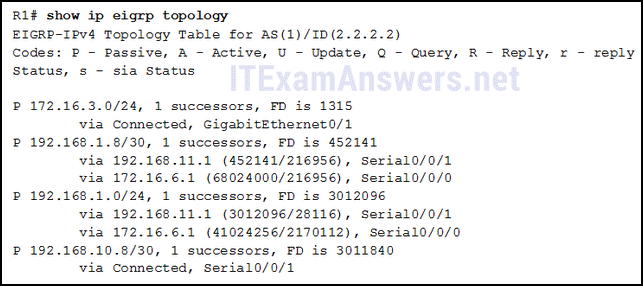 Correct
Correct
Incorrect
Hint
The second entry in the table indicates that there is one feasible successor (“1 successors”) for network 192.168.1.8/30. The last entry in the table shows that network 192.168.10.8/30 is directly connected, so it is not reachable through network 192.168.11.1. The third entry indicates that the reported distances for network 192.168.1.0 are 28116 and 2170112, not 41024256. This same entry shows that neighbor 172.16.6.1 is a feasible successor for network 192.168.1.0. The first entry indicates that R1 has only one successor, not two to network 172.16.3.0/24. -
Question 108 of 115
108. Question
1 pointsA network engineer has manually configured the Hello interval to 15 seconds on an interface of a router that is running OSPFv2. By default, how will the Dead interval on the interface be affected?Correct
Incorrect
Hint
Cisco IOS automatically modifies the Dead interval to four times the Hello interval. -
Question 109 of 115
109. Question
1 pointsWhat command specifies a BGP neighbor that has an IP address of 5.5.5.5/24 and that is in AS 500?Correct
Incorrect
-
Question 110 of 115
110. Question
1 pointsIn a mulitarea OSPF internetwork, which route source descriptor is used to denote the best paths within the internetwork that are as a result of processing type 3 and type 4 LSAs?Correct
Incorrect
-
Question 111 of 115
111. Question
1 pointsRefer to the exhibit. Which two networks contain feasible successors? (Choose two.)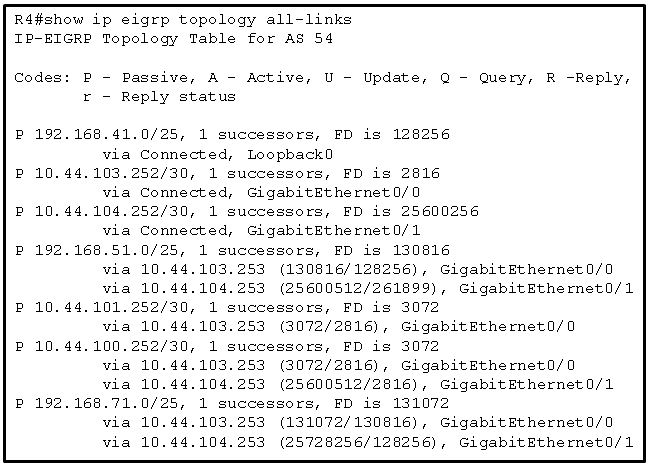 Correct
Correct
Incorrect
Hint
Feasible successors are installed in the EIGRP routing table when the successor becomes unavailable. Feasible successors are backup routes that are have a metric higher than that of successors. -
Question 112 of 115
112. Question
1 pointsRefer to the exhibit. A network engineer has issued the verification command while troubleshooting a routing loop on the network. What is the error in the configuration?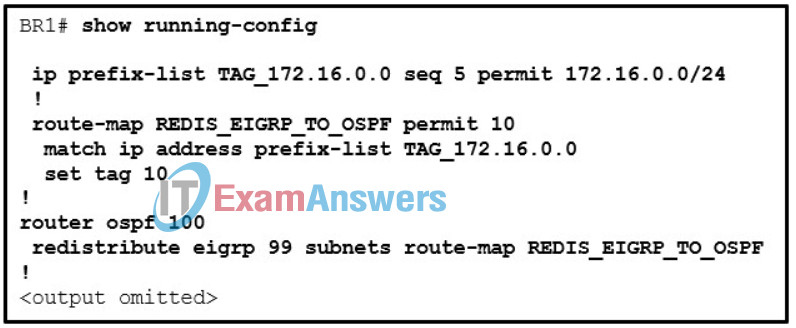 Correct
Correct
Incorrect
-
Question 113 of 115
113. Question
1 pointsHow is a DHCPDISCOVER transmitted on a network to reach a DHCP server?Correct
Incorrect
Hint
The DHCPDISCOVER message is sent by a DHCPv4 client and targets a broadcast IP along with the destination port 67. The DHCPv4 server or servers respond to the DHCPv4 clients by targeting port 68. -
Question 114 of 115
114. Question
1 pointsRefer to the exhibit. What can the field engineer conclude about the EIGRP authentication between RouterA and RouterB?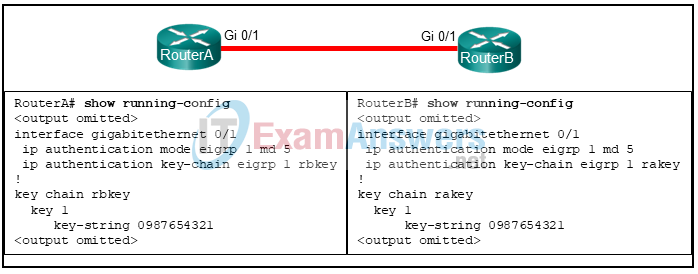 Correct
Correct
Incorrect
Hint
Authentication ensures that only authorized routers are eligible to become EIGRP neighbors. A precomputed password hash is encrypted by using a MD5 authentication and it is included with all EIGRP packets. The hash is computed using the key number and the key string. The receiving router decrypts the hash. If the passwords do not match for a packet, the routers will not become neighbors. In this scenario, the key number and the key string are the same on both routers. Therefore, they will become neighbors. -
Question 115 of 115
115. Question
1 pointsWhat are two features of OSPF interarea route summarization? (Choose two.)Correct
Incorrect
